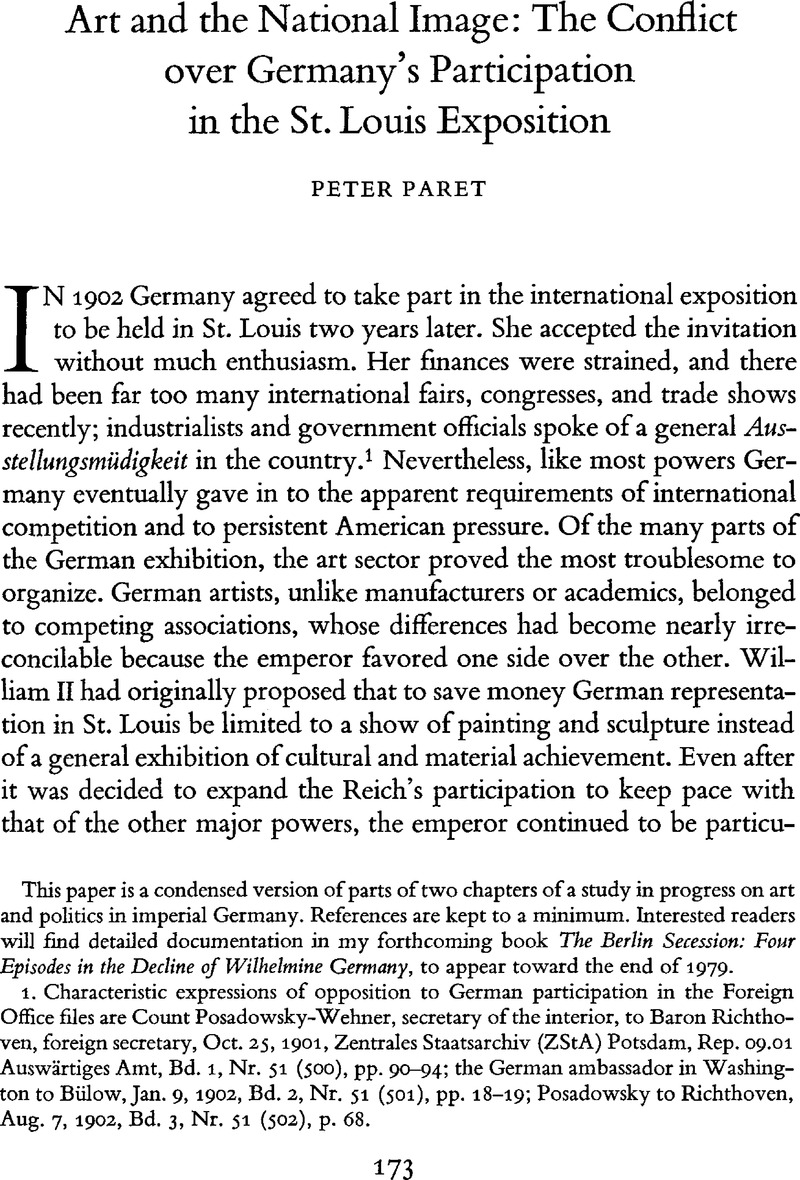Article contents
Art and the National Image: The Conflict over Germany's Participation in the St. Louis Exposition
Published online by Cambridge University Press: 16 December 2008
Abstract

- Type
- Symposium: Government, Social Structure, and Cultural Life in Germany
- Information
- Copyright
- Copyright © Conference Group for Central European History of the American Historical Association 1978
References
This paper is a condensed version of parts of two chapters of a study in progress on art and politics in imperial Germany. References are kept to a minimum. Interested readers will find detailed documentation in my forthcoming book The Berlin Secession: Four Episodes in the Decline of Wilhelmine Germany, to appear toward the end of 1979.
1. Characteristic expressions of opposition to German participation in the Foreign Office files are Count Posadowsky-Wehner, secretary of the interior, to Richthoven, Baron, foreign secretary, 10 25, 1901Google Scholar, Zentrales Staatsarchiv (ZStA) Potsdam, Rep. 09.01 Auswärtiges Amt, Bd. 1, Nr. 51 (500), pp. 90–94; the German ambassador in Washington to Biilow, Jan. 9, 1902, Bd. 2, Nr. 51 (501), pp. 18–19; Posadowsky to Richthoven, Aug. 7, 1902, Bd. 3, Nr. 51 (502), p. 68.
2. On Werner's dislike of Stöcker's “widerliche Bewegung” and his threat of dismissing any student who introduced politics to the classroom, see his memoirs, Erlebnisse und Eindrücke, 1870–1890 (Berlin, 1913), pp. 270–71.Google Scholar
3. The Kultusminister, Bosse, Robert, to William, II, 06 12, 1898, ZStA Merseburg, Königliches Geheimes Civil-Cabinett, Rep. 2.2.1, Nr. 20564, pp. 206–7Google Scholar; Imperial Decree to Bosse, June 17, 1898, ibid., p. 208.
4. Speech of Dec. 18, 1901, in Die Reden Kaiser Wilhelms II., ed. Penzler, Johannes, 3 (Leipzig, [1907]): 60–62.Google Scholar The theme that classical art constitutes an eternally valid but unattainable model returns in other speeches of the emperor, e.g., those of Jan. 25 and Nov. 2, 1902.
5. Müller to Bosse, Dec. 12, 1898, ZStA Merseburg, Kultusministerium, Rep. 76 Ve, Sekt. 1, Abt. IV, Teil IV, Nr. 9, III, pp. 201–4.
6. See, for instance, an interview with Werner published in 1900 and later reprinted in a book on Berlin artists, Norden, Julius, Berliner Künstler-Silhouetten (Leipzig, 1902), pp. 24–25, 27.Google Scholar
7. Bosse to William II, June 4, 1899, ZStA Merseburg, Königliches Geheimes Civil-Cabinett, Rep. 2.2.1, Nr. 20564, pp. 218–22.
8. Katalog der Deutschen Kunstausstellung der “Berliner Secession” (Berlin, 1899).Google Scholar In his thoughtful comment at the session in which this paper was given, George Mosse suggested that the artists of the Berlin secession were politically suspect because they depicted men and women of industrial mass society in their ordinary environment. In my response I agreed that this was true of Käthe Kollwitz, Hans Baluscheck, and a few others; but it is important to note that they constituted a very small minority. At the time the secession was founded, its president, Max Liebermann, who for more than two decades had painted workers and peasants with a cold realism that shocked his contemporaries, was actually turning toward such themes of upper middle-class life as polo players and beach scenes.
9. Liebermann, Max, Die Phantasie in der Malerei (Berlin, 1916), pp. 7–8.Google Scholar The essay originally appeared in 1903.
10. E.g., in its lead-article “Die höhere Macht,” whose title alluded both to the emperor and to the ultimate victory of socialism, Feb. 18, 1904.
11. Sessions of Feb. 15 and 16, 1904.
12. Session of May 10, 1904.
13. Session of Apr. 14, 1904.
14. The German consul general in New York to Bülow, Feb. 6, 1903, reporting on a conversation with an art dealer, ZStA Potsdam, Rep. 09.01 Auswärtiges Amt, Bd. 4, Nr. 51 (503), p. 200.
15. Promemoria of Quadt, A., 10 17, 1902, ZStA Potsdam, Rep. 09.01 Auswärtiges Amt, Bd. 3, Nr. 51 (502), pp. 147–48.Google Scholar
16. Undated Denkschrift submitted to the Kultusminister, who passed it on to the Foreign Office on June 24, 1903, ZStA Potsdam, Rep. 09.01 Auswärtiges Amt, Bd. 6, Nr. 51 (505), p. 103.
17. The German consul general in Chicago to Bülow, Feb. 8, 1905, ZStA Potsdam, Rep. 09.01 Auswärtiges Amt, Bd. 14, Nr. 51 (513), p. 7.
18. In the discussion that concluded the session at which this paper was presented, I thought it important to reiterate the point that the German art exhibition, and by implication German official taste, was no worse than that of other countries represented at St. Louis. It might be added that the catalogue of the German show was far less insistently staatsbejahend than that of the French, which listed every artist's major prizes, and carefully distinguished between chevalier and officier of the Legion of Honor. The difference that did—and does—seem worth emphasizing is that the German government showed less tolerance of aesthetic variety, let alone dissent, and was less hesitant than its counterparts in France or England to take extraordinary steps to create a cohesive, unitary image of national art.
- 4
- Cited by




